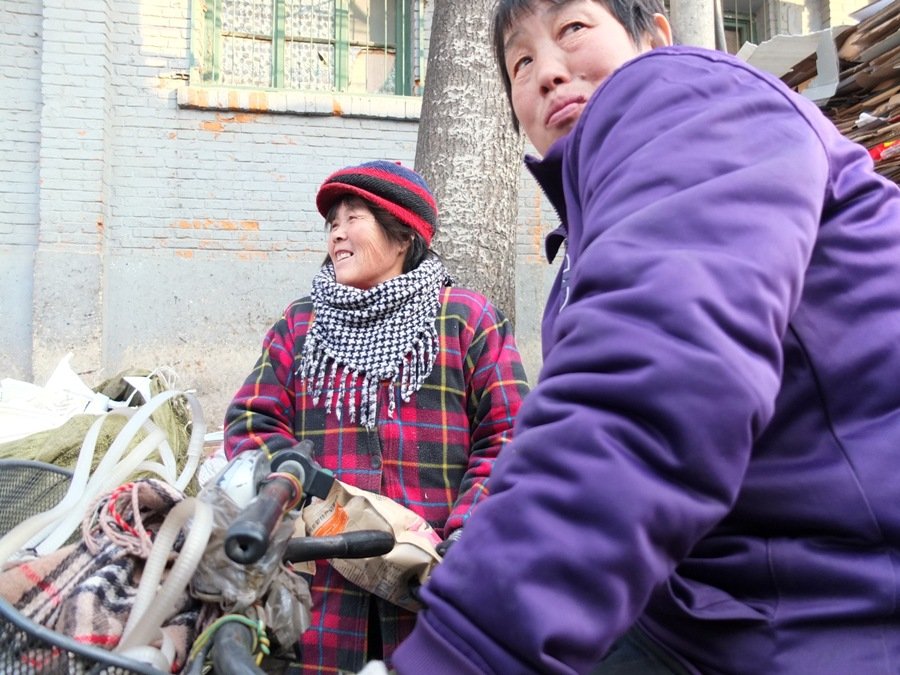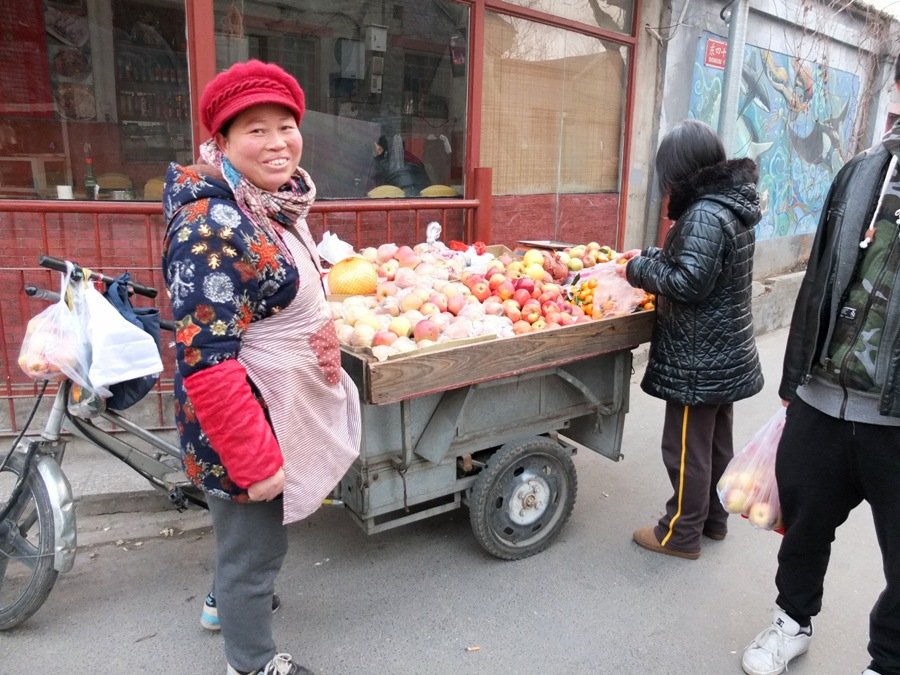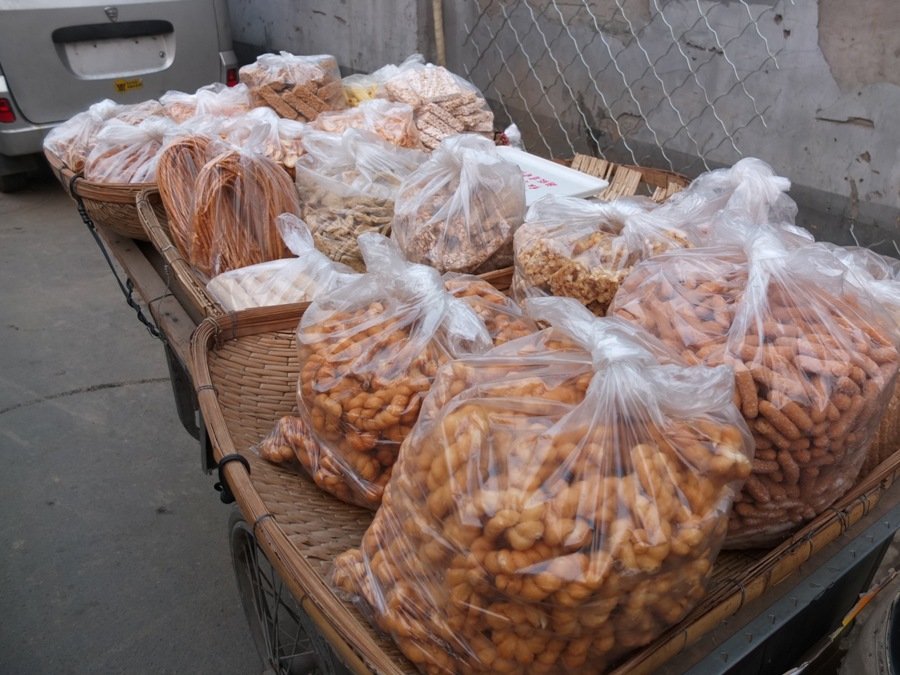Hutong Hawkers: The Fading Food Trade of Beijing’s Vagabond Salesmen
Like clockwork, I awake to the heather light of a dawn in the hutongs and the gruff call of a shangfan, or street vendor, gently rolling on his bicycle, bellowing into the siheyuan as he passes. I curse him, hope he takes a sick day tomorrow, and roll over to bag an extra 30 minutes of sleep. However, despite my personal issues with his antisocial work schedule, the lone man’s particular routine intrigues me enough to investigate his trade and apparently austere means of subsistence, remains of which have long vanished in my home country. In an attempt to learn more, I take to the arteries between Beixinqiao and Zhangzizhong Lu to explore the overlapping roles that shangfan play in the fabric of hutong food culture.

I first notice that the several shangfan that mosey down my alley throughout the day provide an invaluable service to the older, less mobile members of the community and the businesses in the greater neighborhood, often working in one specific trade and covering enough ground to make their choice of living practical. I wonder how they assign their elusive routes and find to my surprise that rather than heading out to track them down, it would have been more fruitful had I merely waited to pounce on them from my front door. Nevertheless, in the surrounding area I encounter recyclers (the aforementioned half-man, half-cockerel), knife sharpeners, handymen, and suppliers of various wares and consumables, ranging from house utensils and fans to produce and eggs.
The hawkers employ various methods to secure the attention of nearby residents and restaurants. Some are lucky enough to peddle food inherently fragrant and alluring, such as the ubiquitous subway sweet potato man. Others opt for a tried and tested battle cry, or yaohe, that through years of repetition has gnarled into something entirely incomprehensible but wholly distinctive – all gut and throat – ensuring recognition through the dense hutong warren. These unique hollers can be recorded and played through a loudspeaker for those less inclined to tear their larynx to ribbons. Few still employed instruments, or xiangqi, a method primarily lost to a Beijing past, which are either struck or shaken, generating a unique chime of clank so as to also be identifiable by trade to the prospective customer.
Despite their differences in approach, each individual, whether providing a specific skill or commodity that centers around eating or collecting the byproducts of consumption in the form of refuse and recyclables, hopes to tap into a localized market with a loyal audience that seeks their expertise. Unfortunately, one uniting opinion among the recyclers and food sellers that I spoke to was that business was dwindling and significantly worse than even a year ago. Trade opportunities are likely shrinking, in part due to the ease and convenience of online shopping. Many are also feeling the bite from the growing number of larger, more diversified fruit markets and the perceived quality and customer relations that each of these more polished outlets provide.

Manning his sanlunche, which doubles as a portable storefront and saving on the additional rent that such a space would require, one apple vendor described how it was no longer viable for him to truck the fruit in from his family-owned orchard in the suburbs of Beijing, as business had shrunk in the three short years since he had become a street hawker, adding that his job, “lacks any prospects.” He put his waning income down to people no longer bulk-buying fruit, foregoing home-cooked meals, and opting to eat out instead. Likewise, a life-long mandarin seller nearby told of how on bad months she barely secures enough money to cover rent and she doesn’t dare change professions, commenting on her low education and a lack of the capital that it would require to invest in a new project. Winter hardships have also taken their toll – migrants have returned home and fewer potential patrons mill the hutongs.
The added pressures of increasing government control on retail and public space have also put the street merchants’ livelihood in danger, with chengguan – urban management officials – often making the rounds to chase unlicensed hawkers away. The unlucky will receive a fine of a few hundred yuan – on average a tenth of their monthly takings – not crippling but enough of a pinch to make them think twice about returning and securing their place as a trusted vendor.

It is for these reasons that the fate of Beijing’s shangfan hangs in the balance, their occupations squeezed between slumping demand, growing regulations, and the feasibility of a singular, often seasonal trade paying the bills year-round. Even from just a handful of anecdotes, it’s hard not to imagine the reverberation of the few xiangqi that remain as a death knell for a hardy but fading occupation. For that reason, I still curse my early morning recycling man but I also hope to hear him make his rounds come spring.
To hear reconstructions of various xiangqi and other aural artifacts of old Beijing, visit the Beijing Sound History Project’s permanent exhibition at the Shijia Hutong Museum (Tue-Sun 9.30am-4.30pm. 24 Shijia Hutong, Dongcheng District).
Additional translation by Patrick Li.
More stories by this author here.
Email: tomarnstein@thebeijinger.com
WeChat: tenglish_
Instagram: @tenglish__
Photos: Tom Arnstein
Comments
New comments are displayed first.Comments
![]() a6666667890
Submitted by Guest on Sun, 01/03/2016 - 15:46 Permalink
a6666667890
Submitted by Guest on Sun, 01/03/2016 - 15:46 Permalink
Re: Hutong Hawkers: The Fading Food Trade of Beijing’s...
Feeling a lot.
On the one hand, the mode of operation of the conflict. Beautiful store, even if the price is expensive, people rarely choose street small stalls.
On the other hand, the change of the diet. More and more Chinese people, the habit to eat cake and bread for breakfast. Soybean milk, Fried dough sticks, steamed stuffed bun, natural selling less.
At the end of the day, the east and the west is not the same as the way of life.
Now China, people's life style has changed. Inevitably, will eliminate many shops, many industries.
Validate your mobile phone number to post comments.

